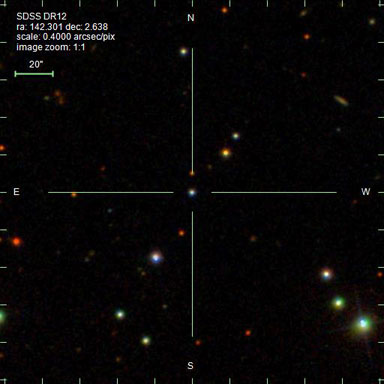The formation of the first generations of stars is a mystery which astrophysicists are searching to understand.
The Universe emerged from a very hot state (109 K), called the « Big Bang », with a very simple chemical composition : just the light elements hydrogen, helium and minute quantities of lithium.
The creation of small mass stars from a gas made up of these elements is a complex phenomenon. Since, although gravity does tend to collapse the gas, the ensuing compression heats it up and so stops the collapse.
The presence of heavier elements such as carb on, oxygen etc leads to a cooling of the gas during its collapse [1] is made up of two almost identical stars.
Spectra obtained using the spectrograph UVES on ESO’s 8,2 m VLT (Observatoire austral européen), show clearly the presence of two stars ; radial velocities measured using the Doppler effect Doppler [2] show that these stars orbit the same centre of mass. This is an important discovery, since it confirms that primordial gas clouds fragment and form binary systems. The data are as yet insufficient for a determination of the orbits of these stars.
Farther observations are foreseen in order to improve the data ; « With more data, we will be able to determine the orbit, and so have important information about the messes of these stars. », notes Elisabetta Caffau.
And this couple continues its binary dance, which has been going on for 13 billion years.
[1] The cooling due to the presence of elements such as carbon and oxygen has two sources : firstly, collisional excitation of atoms followed by radiative de-excition ; secondly, heating of dust grains by atomic collisions, followed by radiation of this energy through the emission of photons (observed in the far infra-red).] which facilitates the formation of small mass stars.

Although the star in the centre looks isolated, it is in fact distant binary.
*
Stars, witnesses of the past
These small mass stars are still there : they are true messengers which carry vital information about the Universe such as it was 13 billion years ago.
In point of fact, the lifetime of these stars is extremely long, almost as long as the age of the Universe.
One has so far never discovered a star with a primordial chemical composition (just hydrogen and helium), but we have found a handful of stars containing very little heavy elements (with, for example, 1/100 000 less iron than the Sun). These stars are the direct descendants of the first generation of stars (which furnished a few heavy elements). The heavy element composition of these small stars yields vital information about the massive stars whch furnished these observed chemical elements.
One of the hypotheses for the formation of the first stellar generrations invokes the the pssibility that the collapsing gas cloud fragments into many small parts. Theory predicts that such fragmentation always takes place.
One expects, as a consequence of this process the formation of binary or multiple star systems. However, till now, no star poor in iron (1/100000 less than in the Sun) has been found in a multiple star system.
An important discover
An international team led by Elisabetta Caffau, CNRS research director at the Paris Observatory, has discovered that the system SDSS J092912.32+023817.0 [[The abundance of iron with respect to hydrogen (Fe/H) in the stars in these systems is 10-5 times that in the Sun.
[2] The Doppler effect is the change in the frequency of the radiation received due to the motion of the source with respect to the observer. If the source is approaching, the frequency is higher ; if the source is receding, it is lower. In a binary star, the orbital motion gives rise to a periodic change in the observed frequency, depending on whether the star is approacching or receding the observer.
